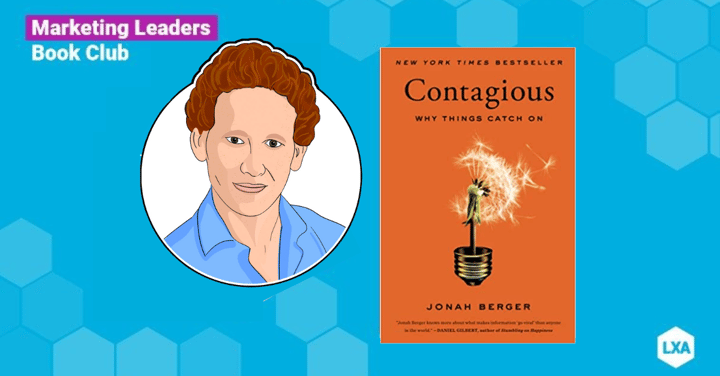
We're bringing you the best insights written in the world of marketing today, thanks to our sponsors at Treasure Data.
“Virality isn’t born, it’s made," Jonah Berger says. In his book Contagious, he takes this idea further, exploring why and how certain ideas and products spread wider and faster than others.

Jonah acknowledges that we assume some concepts or products become popular randomly, or out of sheer luck. One video might go viral, another similar one may fall completely under the radar. So, the internet might seem like an impulsive, unpredictable space if you avoid analysing it.
By understanding this landscape, and why it works the way it does, Jonah developed the 6 STEPPS or ingredients needed to create viral content that will be easily spread by word-of-mouth.
These insights are highly useful for anyone who wants to build awareness, spread ideas, or grow a customer base more effectively.
Why Tipping Point is Vital for Any Modern Marketer
“Making things more observable makes them easier to imitate, which makes them more likely to become popular.”
- Jonah Berger
Many believe the virality of a product or piece of content is based on three things. Quality, price, and advertising. These are often relevant, but they don't paint an entire picture. For example, a low-quality, free YouTube video can go viral, with no advertising or promotion.
This would be an example of social influences and word-of-mouth making a huge difference. In fact, these two things drive 20-50% of all purchasing decisions. These include product reviews, and recommendations by friends/colleagues, amongst other things.
Word of mouth tends to be more impactful than traditional advertising, for a few reasons:
- It's more persuasive. Every day people tend to share the pros and cons of a product or service candidly, making their recommendations more objective, balanced, and believable.
- It's more targeted. Personalisation comes easy, as people tend to only share information and stories with people whom they think will be interested in them.
“Word of mouth is the primary factor behind 20 per cent to 50 per cent of all purchasing decisions.”
- Jonah Berger
About the Author
Jonah Berger is a professor at the Wharton School of the University of Pennsylvania. He is also a bestselling author. His expertise focuses on change, word of mouth, viral marketing, social influence, and how products, ideas, and behaviours catch on.
He has published over 50 articles in academic journals and has written for The New York Times, Wall Street Journal, and Harvard Business Review.
His books Contagious: Why Things Catch On, Invisible Influence: The Hidden Forces that Shape Behaviour, and The Catalyst: How to Change Anyone's Mind are in print in over 35 countries around the world.
Top Takeaways
“How does it make people look to talk about a product or idea? Most people would rather look smart than dumb, rich than poor, and cool than geeky. Just like the clothes we wear and the cars we drive, what we talk about influences how others see us.
It’s social currency. Knowing about cool things—like a blender that can tear through an iPhone—makes people seem sharp and in the know. So to get people talking we need to craft messages that help them achieve these desired impressions. We need to find our inner remarkability and make people feel like insiders.
We need to leverage game mechanics to give people ways to achieve and provide visible symbols of status that they can show to others.”
- Jonah Berger
The 6 STEPPS are the most well-known takeaway from the book. They are as followed:
- Social currency. People share ideas that make them appear cool, informed, smart, or a similarly positive attribute. So, marketers can create social currency by making their product/idea remarkable, leveraging game mechanics, and using scarcity and exclusivity.
- Triggers. People often bring up what's at the forefront of their minds. So, we can create effective triggers that meet three criteria, being frequency, relevance, and context. For example, take the Mars Candy Company. In 1997, a NASA mission to Mars gained traction in the news, and sales of Mars candy bars spiked. Despite the candy company having nothing to do with the NASA mission, the frequent news cycle triggered the idea of the candy in people’s minds.
- Emotion. Both positive and negative emotions can spur action. It just has to cause a level of arousal. This principle will allow marketers to find their emotional hook or situational factors for emotional arousal.
- Public. We're more likely to discuss and imitate something that's public and observable. So, this step suggests marketers should create social proof using self-advertising, and behavioural residue.
- Practical value. People like to help people. Which is lovely. So, we'll pass on content that contains a practical value that will help the recipients. So, it's important to highlight the incredible value and package your content accordingly.
- Stories. Stories work. They are a fast and easy way for people to pass on lots of info in an engaging and persuasive way. So, marketers can embed their product into a captivating story, and ensure the brand is an integral part of the narrative.
Link to purchase page
Purchase Contagious on Amazon and Audible.
Other Books You May Be Interested In
- Thinking, Fast and Slow - Daniel Kahneman
- The Choice Factory - Richard Shotton
- How to Make the World Add Up - Tim Harford
- Made to Stick - Chip and Dan Heath
